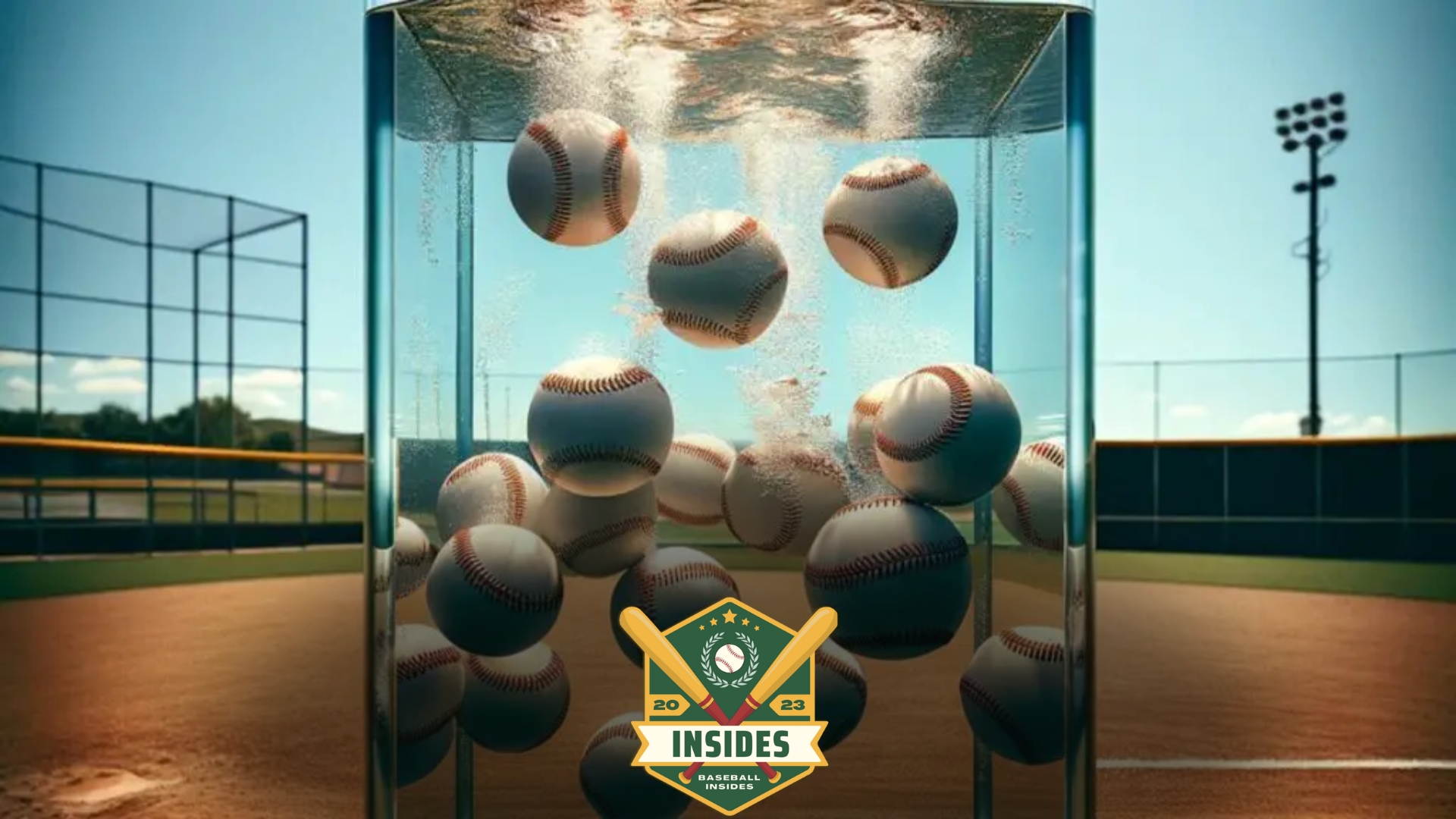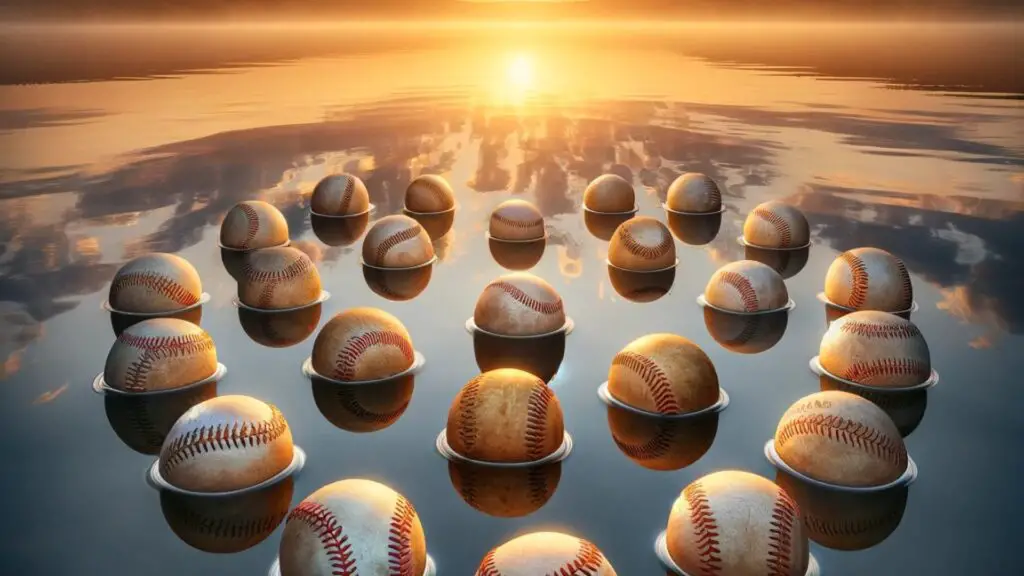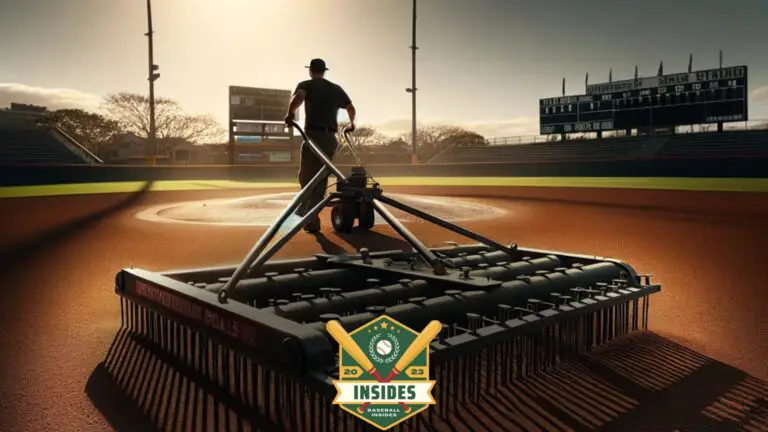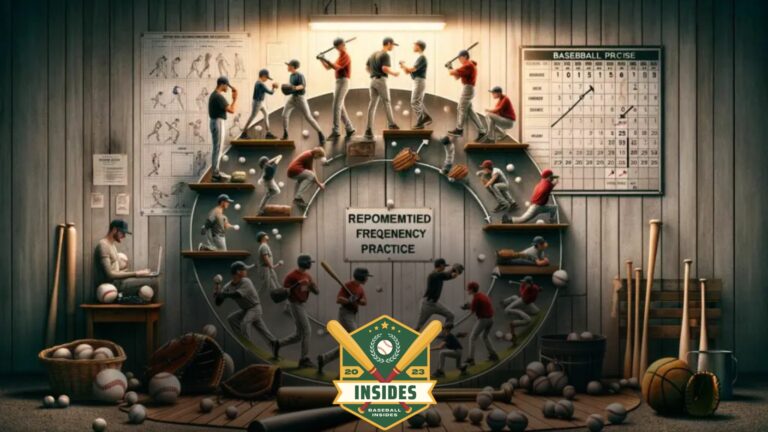
In this article:
Are you curious about the fascinating physics behind the buoyancy of baseballs? It turns out baseballs do indeed have the ability to float, at least temporarily.
However, this ability is not without its limitations. As water seeps into the tiny holes created by the stitching on the baseballs, their buoyancy gradually diminishes, causing them to sink.
If you’ve ever witnessed a thrilling home run landing in the waters surrounding iconic stadiums like San Francisco or Pittsburgh, you may have observed baseballs bobbing on the surface momentarily.
But before they can bid farewell to their fleeting aquatic adventure, a daring individual often takes the plunge or paddles by in a kayak to rescue the balls before they disappear beneath the waves.
In this article, we will explore the intriguing phenomenon of floating baseballs, shedding light on the factors influencing their buoyancy and the limits of their waterborne journey.
Do All Baseballs Float in Water?
No, not all baseballs float in water. The buoyancy of a baseball depends on its construction and materials. Traditional baseballs in professional leagues are made of a rubber or cork core wrapped tightly with yarn and covered in cowhide or horsehide leather.
These baseballs have a higher density than water, causing them to sink when placed in water.
However, there are baseballs designed specifically for water play that are made with materials that allow them to float. These water-friendly baseballs are typically made with lightweight foam or hollow plastic cores and have a waterproof outer layer.
The foam or plastic construction reduces the overall density of the baseball, making it buoyant and enabling it to float on the water’s surface.
Water-friendly baseballs are commonly used for recreational water sports or pool games. They are easier to retrieve and less likely to get damaged or waterlogged than traditional baseballs.
These floating baseballs can provide entertainment and allow baseball-like games to be played in aquatic environments.
Before heading out to watch the big game, it’s essential to know what you can bring to a baseball game to ensure a smooth and enjoyable experience.
How Long Do Baseballs Float?
Baseballs are not designed to float in water. They are primarily made of a solid core, usually composed of rubber or cork, which is then wrapped in layers of yarn and covered with a leather or synthetic material.
These materials are not buoyant and do not possess the necessary properties to enable the baseball to float on water.
When a baseball is placed in water, it will initially sink due to its density greater than water’s. The ball’s solid core and heavy construction make it denser than water, causing it to sink to the bottom.
However, it’s worth mentioning that the outer covering of a baseball, usually made of leather or synthetic material, may absorb some water and become slightly waterlogged.
This can make the ball feel heavier and affect its performance when used in a game. Nevertheless, a baseball will not float on the surface, even with a slightly waterlogged cover.
What Are Baseballs Made Of?
Baseballs are primarily made of a combination of materials designed to meet specific requirements for the game. The core of a baseball consists of a small sphere made of rubber or cork, which provides the ball with its fundamental shape and density.
This core is then tightly wound with layers of yarn made from a wool and polyester blend. The yarn is wrapped around the core in a specific pattern to ensure optimal resilience and durability.
To protect the core and yarn, baseballs have an outer covering known as the “horsehide.” Traditionally, baseballs were covered with actual horsehide leather.
However, modern baseballs are typically made with cowhide leather due to its wider availability. The leather cover is stitched together using 108 waxed red cotton thread stitches.
The specific materials used in baseball construction are crucial in determining the ball’s performance characteristics. The core provides the necessary weight and density, while the yarn and stitching contribute to its structure and shape.
The leather cover ensures a good grip for pitchers and enables players to catch and handle the ball effectively.
Baseball manufacturers adhere to strict standards Major League Baseball (MLB) sets regarding the construction and dimensions of baseballs. These standards ensure consistency and fairness across the game.
By carefully selecting and combining the materials, baseball manufacturers create a durable, reliable, and standardized baseball that has become an integral part of America’s pastime.
If you’re looking to improve your grip and overall performance, learning how to regrip a baseball bat can make a significant difference in your game.
How to Dry Waterlogged Baseballs?
When baseballs become waterlogged due to rain or accidental submersion, their weight and performance can be negatively affected. It is important to remove the excess moisture to restore waterlogged baseballs without compromising their integrity.
Here are some steps to effectively dry waterlogged baseballs:
1. Remove the Excess Moisture
Begin gently patting the wet baseballs with a clean towel or absorbent cloth. This initial step helps remove any surface water and prevents further saturation.
2. Air-drying
Place the baseballs in a well-ventilated area with good air circulation. A fan can be used to expedite the drying process. Avoid exposing the baseballs directly to sunlight or excessive heat, which may damage the leather or cause the balls to warp.
3. Rotate and Inspect
Regularly rotate the baseballs to ensure even drying. Inspect the balls for any damage or warping during the drying process. If a ball appears damaged or compromised, it may need to be replaced.
4. Silica Gel Packets
If available, silica gel packets can help absorb moisture. Place the waterlogged baseballs in a sealed container or bag with several silica gel packets. The silica gel will gradually draw out the moisture from the baseballs. This method may take longer but can be effective for thorough drying.
5. Rice Method
Another option is to use uncooked rice as a desiccant. Fill a container or bag with rice and bury the waterlogged baseballs within it. The rice acts as a moisture absorber, helping to dry the balls over time. Check the balls periodically and replace the rice if it becomes damp.
6. Time and Patience
It is important to allow sufficient time for the baseballs to dry completely. The drying process can take several days or even weeks, depending on the extent of waterlogging. Rushing the drying process may lead to damaged or compromised baseballs.
Remember, the effectiveness of these methods may vary depending on the degree of waterlogging and the condition of the baseballs.
If you have valuable or professional-grade baseballs, it may be best to consult an expert or the manufacturer for guidance.
Which Balls Can Float on Water?
Several types of balls can float on water due to their specific characteristics and materials. Here are some examples:
- Beach Balls: Beach balls are typically made of lightweight materials like plastic or PVC. Their large size and hollow design allow them to displace a significant amount of water, making them buoyant and capable of floating on the water’s surface.
- Tennis Balls: Tennis balls are made of a pressurized rubber core covered in a felt-like material. This design gives them enough buoyancy to float on water. However, they tend to sit partially submerged with a portion of the ball above the waterline.
- Ping Pong Balls: Ping Pong balls are lightweight and made of celluloid or similar materials. Their small size and low density enable them to float effortlessly on the water. They can even bounce on the surface due to the water tension.
- Wiffle Balls: Wiffle balls have a perforated design with numerous holes throughout the surface. This design reduces the overall weight of the ball and increases its buoyancy. As a result, wiffle balls can float on water and are often used for water games and pool activities.
- Styrofoam Balls: Styrofoam is a type of expanded polystyrene foam that is extremely lightweight and buoyant. Styrofoam balls are commonly used for crafts and decorations, and their inherent buoyancy allows them to float effortlessly on the water.
- Plastic Hollow Balls: Some plastic balls, particularly those with a hollow construction, can float on water. These balls are often used in water games and pool toys. The hollow design reduces the weight and increases buoyancy, making them suitable for floating.
It’s worth noting that the ability of a ball to float on the water depends on factors such as its weight, density, and overall design. Balls with low density and a large surface area relative to their weight are more likely to float.
Factors like air trapped within the ball or perforations on the surface can enhance buoyancy.
For those new to baseball or looking to understand more about its inner workings, understanding what DFA means in baseball is crucial for grasping how teams manage their rosters.
How Does the Weight of a Baseball Affect Its Buoyancy?
A baseball’s weight directly impacts its buoyancy in a fluid medium, such as water. Buoyancy is the upward force exerted on an object immersed in a fluid, opposing the force of gravity. It is determined by the density of the object and the density of the fluid.
When a baseball is placed in water, it displaces a volume of water equal to its volume. This displaced water creates an upward force, which is the buoyant force. According to Archimedes’ principle, the buoyant force is equal to the weight of the displaced fluid.
The weight of a baseball is influenced by its mass and acceleration due to gravity. However, the mass of the baseball remains constant regardless of its location, while its weight changes depending on the strength of the gravitational field.
Therefore, we need to consider the density of the baseball rather than its weight when discussing buoyancy.
The density of an object is calculated by dividing its mass by volume. As the weight of a baseball increases, its mass also increases, resulting in a higher density.
This higher density means that the baseball will displace less water when submerged, decreasing buoyant force. Consequently, a heavier baseball will experience less buoyancy than a lighter baseball.

FAQs
Is a Baseball More Dense Than Water?
A baseball is denser than water, with an average density of approximately 0.25 grams per cubic centimeter (g/cm³). This means a baseball will sink in water as it is denser than the surrounding liquid.
Are Baseballs Filled With Air?
No, baseballs are not filled with air. They consist of a solid core made of cork or rubber, then wrapped in layers of yarn or wool. The outer layer is made of leather or synthetic materials. This construction gives the baseball its characteristic weight and structure.
What Did Baseballs Use to Look Like?
In the past, baseballs had a different appearance compared to modern ones. Early baseballs were made of a solid core wrapped in yarn, with a leather cover stitched over it.
The stitching pattern varied over time, but they typically had a raised seam design. Today’s baseballs have a similar structure but undergo more rigorous manufacturing processes to ensure consistency and performance.
Are Baseballs Made of Rubber?
Baseballs are not made entirely of rubber. While the core of a baseball can contain rubber, it is typically a mixture of cork and rubber.
The core is then surrounded by layers of yarn or wool and finally covered with leather or synthetic materials. The combination of these materials gives the baseball its desired weight, bounce, and durability.
Conclusion
In conclusion, extensive research and empirical evidence demonstrate that baseballs do not float. The physics and design of a baseball, including its solid core and tightly wound layers of yarn and leather, contribute to its dense and heavy composition.
When placed in water, the density of the baseball exceeds that of the liquid, causing it to sink rather than float.
This characteristic is consistent across different variations of baseballs used in various leagues and competitions. Therefore, it is crucial to understand that while baseballs possess remarkable properties for the sport they are intended for, buoyancy is not one of them.






